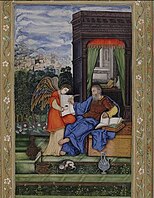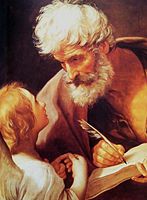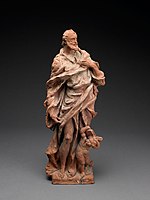Mataio
Mataio | |
|---|---|
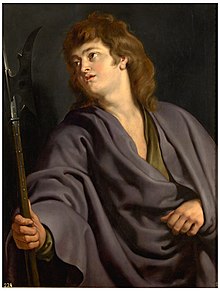 Santo Mataio (a.t. 1611) nigambaraini Peter Paul Rubens | |
| Nifahaö, Sanura Injil, Martir | |
| Tumbu | Kafanauma,[1] Galilaia, Kerajaan Romawi |
| Mate | Ngaotu ndröfi si-1 Etiopia |
| Tefolakhömi ba | Gereja Ortodoks Timur Gereja Katolik Gereja Katolik Timur Ortodoks Timur Gereja Timur Persekutuan Anglikan Gereja Lutheran |
| Owasa khönia | 21 September (niha Keriso ba Barat) 22 Oktober (Ortodoks Koptik) 16 November (niha Keriso ba Timur) |
| Simbol | Mala'ika |
| Nilumö'önia | Akuntan; kota Salerno (Italia); ira sohalöŵö ba bank; sangowuloi bea; ya'ira samazökhi parfum; pegawai negeri[2] |
| Sinurania | Turia Somuso Dödö Nisura Mataio |
Mataio (li Ibrani מַתִּתְיָהוּ, te'adogo'ö מַתִּי; li Aramaia ܡܰܬ݁ܰܝ; li Yunani Μαθθαῖος; li Koptik ⲙⲁⲧⲑⲉⲟⲥ; li Latin Matthaeus; li Indonesia Matius) ma asese lakaoni ia Santo Mataio no töi samösa moroi ba gotalua ndra nifahaö Yesu si felendrua. Molo'ö tradisi niha Keriso, ya'ia göi samösa moroi ba gotalua zi daöfa zanura Injil, sanura Sura Mataio, ba börö da'ö tehöngö göi ia faoma töi Mataio Sanura Injil, sambua döi si lö latema arakhagö fefu gere Zura Ni'amoni'ö, heŵa'ae so göi zanohugö manguma'ö wa Mataio zanura Injil andrö.[3]
Isura Amabu'ulali Sibohou wa i'o'ö Yesu Mataio tobali nifahaö Yesu. Furi da'ö laŵaö ira tua Gereja simane Ireneus ba Klemens moroi ba Aleksandria wa ituriagö Injil Mataio khö ndra angowuloa Yahudi ba danö Yudea, fatua lö awu'a ia ba negara bö'ö.
Mataio bakha ba Gamabu'ulali Sibohou
[bulö'ö | bulö’ö kode]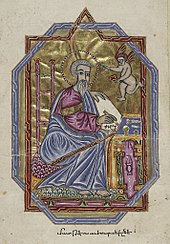
Bakha ba Mataio 9:9 awö Mataio 10:3 tetötöi Mataio samösa niha sangowuloi bea ba Kafanauma, si dadao ba gödo wanema bea me tekaoni ia wolo'ö Yesu. Tefa'oli göi ia ba gotalua ndra nifahaö si felendrua, ba hiza lö nisura sanandrösa heza moroi ia bakha ba Mar 3:18, Luk 6:15 ba ba HalZin 1:13. Ba ayati si fagölö ba Mataio 9:9, lasura Mareko 2:14 ba Luka 5:27 zanandrösa ba wogaoni Lewi, sanema bea, ono Alfeus, ba hiza lö irai latötöi Injil Mareko ba injil Luka wa Lewi andrö no samösa moroi ba gotalua ndra nifahaö si felendrua.
Halöŵö fa'a'enoni
[bulö'ö | bulö’ö kode]Ituriagö Amabu'ulali Sibohou wa i'o'ö Yesu Mataio, tobali samösa nifahaö. Aefa da'ö la'iagö sambua lote ira nifahaö (HalZin 1:10-14) (latötöi ia kenakel ba gotalua ndra niha Keriso me föna) ba Yerusalema.[4] Toröi ndra nifahaö ba Yerusalema ba ba mbanua sifasui ba laturiagö wa Yesu andrö no Keriso.
Ba mbuku Talmud Babilonia (Sanhedrin 43a), tesura wa "Mattai" andrö no samösa moroi ba gotalua zi dalima nifahaö "Jeshu".[5]
Laŵaö ira tua Gereja simane Ireneus (Against Heresies 3.1.1) ma zui Klemens moroi ba Aleksandria wa ituriagö Injil Mataio khö ndra niha Yahudi ba danö Yudaia, fatua lö möi ia ba mbanua zobanua. Lö la'ila ya'ira sanura me föna hadia mbanua zobanua andrö, ba hiza latötöi Etiopia arakhagö fefu gumbu zura.[4] Ira Gereja Katolik ba Gereja Ortodoks la'o'ö tradisi wa mate Mataio tobali martir (niha nibunu börö wamatinia) ba hulö i'ombakha'ö hewisa labunu ia Talmud Babilonia bakha ba Sanhedrin 43a.[6][7]
Molo'ö tradisi Gereja, me möi mangombakha Mataio ba Etiopia, ibe'e tobali niha Keriso Ephigenia, ono alawe khö razo Etiopia Egippus[8] ba aefa da'ö te'angaruwusi ia tobali biarawati. Me i'ali Egippus razo Hirtacus, i'andrö khö Mataio ena'ö tola omasi Ephigenia mangowalu khönia. Börö da'ö ikaoni razo Hirtacus Mataio ena'ö fao ia ba misa ba hari migu föna da'ö. Bakha ba misa andrö ihöwö razo Hirtacus andrö Mataio ba wangisönia Ephigenia, si no tobali biarawati ba börö da'ö no sangowalu khö Keriso. Bakha ba wönunia ifatenge zaradadunia razo andrö ba wamunu Mataio si sindro nasa ba altar, irege tebunu ia tobali martir.[9]
Injil Mataio
[bulö'ö | bulö’ö kode]
Ifaduhu'ö tradisi Gereja meföna wa Mataio zanura Turia Somuso Dödö nisura Mataio. Si föföna sibai manguma'ö da'a ya'ia ngawalö zinura moroi ba ngaotu ndröfia si sara ba si dua, simane sinura uskup Papias moroi ba Hierapolis (a.t. döfi 60–163),[10] sangai niŵaö Eusebius, samösa ere Hikaya Gereja (döfi 260–340), imane: "I'owuloi ngawalö ngawua wehede (logia: nidunö-dunö khö Yesu) ba li Ibrani Mataio, ba ifo'eluaha ia ndrege wa'abölönia."[11][lower-alpha 1][12] Simanö göi iŵa'ö teolog sotöi Origenes (a.t. 184 – a.t. 253) wa Injil si föföna no nisura Mataio,[13][14] ba wa Injil andrö khönia no tesura ba li Ibrani ba zahatö ba Yerusalema si lalö khö ndra niha Keriso Ibrani ba ni'ali ba li Yunani. Injil asli ba li Ibrani andrö te'irö'ö ba perpustakaan Kaisaria. Ba gangahorita ngaotu ndröfia si öfa lafazökhi sambua kopi Injil andrö ira fa'awösa Nazarene ba labe'e ia khö Hieronimus[15] ni'oguna'önia dania ba halöŵö wangosili Zura Ni'amoni'ö.[16] Latötöi Injil Mataio me luo da'ö Turia Somuso Dödö molo'ö niha Heberaio[17] ba itaria göi Turia Somuso Dödö ndra Nifahaö[18][19] ba faduhu dödö niha me luo da'ö wa injil andre no tanömö zura asli Mataio Yunani si so bakha ba Zura Ni'amoni'ö.[20] Ba hiza no latenaŵa da'a ira ere Zura Ni'amoni'ö modern simane Bart D. Ehrman ba James R. Edwards.[21][22] Faigi göi nifotöi hipotese dombua-gumbu.[23][24][25]
Ha sambalö latema'ö arakhagö fefu gere Zura Ni'amoni'ö modern wa sanura Injil Mataio no niha bö'ö si lö ta'ila töi ba tenga Mataio samösa.[26][3] Lö nibe'enia döinia bakha ba teks sanura injil Mataio ba molo'ö ndra ere Zura Ni'amoni'ö, awena ba ngaotu ndröfia si dua tenönö döi zura "molo'ö Mataio".[27][28]
Injil bö'ö si lö resmi ("apokrif")
[bulö'ö | bulö’ö kode]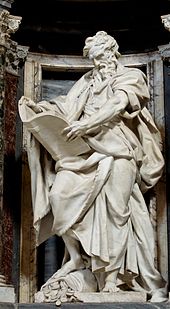
Ba ngaotu ndröfia si tölu, la'oguna'ö injil Keriso-Yahudi niböbögö khö Mataio ya'ira niha Keriso Yahudi simane fa'awösa Nazarene ba fa'awösa Ebionita. Tesöndra gakhökhöla si toröi moroi ba injil andre bakha ba zura Hieronimus, sura Epiphanius ba ba zura tanö bö'ö. La'o'ö wamaosatö ngawalö zura andre arakhagö fefu zangosili Zura Ni'amoni'ö: Injil ndra fa'awösa Nazarene (36 fragmen), Injil ndra niha Ebionita (7 fragmen) ba Injil ndra niha Yahudi (7 fragmen) si tesöndra bakha ba Gamabu'ulali Sibohou apokrif[29] nifa'anö Schneemelcher. Laŵa'ö ira komentator si no mangosisi'o ngawalö teks andre wa tesura ia ba li Yunani ba tefaböbö ia ba Mataio Yunani.[30] So ösa ndra komentator sanguma'ö wa teks andre no akhökhöla (li Indonesia fragmen) moroi ba injil asli ba li Ibrani ba ba li Aramaia si no taya.
Injil nifotöi Pseudo-Mataio no sambua zura nifa'anö ba ngaotu ndröfia si fitu moroi ba zi tölu zura apokrif tanö bö'ö ya'ia da'ö Injil Yakobus, Foloi ba Mesir, ba Injil Nono Side-ide nisura Tomas.
Ifasinga Hieronimus, wa molo'ö ndra fa'awösa Nazarene, Injil Heberaio khöra no nisura Mataio [16] heŵa'ae laŵa'ö ira Ireneus ba Epiphanius moroi ba Salami wa sindruhunia injil andre ha nisura mangawuli Injil resmi (kanonik). So ma'ifu nösi Injil andre si tesöndra ba ngawalö zura ndra tua Gereja, niŵa'ö nisura Mataio.[24] Lö iŵa'ö Epiphanius wa Mataio zanura Injil Heberaio, ha iböbögö wanguma'ö simanö khö ndra Ebionita (sambua wa'awösa niha Keriso selungu).[25]

Fanörö-tödö khönia
[bulö'ö | bulö’ö kode]Latema'ö Mataio tobali samösa niha ni'amoni'ö (santo) ya'ira Gereja Katolik, Gereja Ortodoks Timur, Gereja Lutheran[31] ba Gereja Anglikan. La'owasaini wanörö-tödö khönia ero 21 September ba Barat ba ero 16 November ba Timur (Ba gereja-gereja solo'ö kalender Julian te'aekhugö ia ero 29 November kalender Gregorian modern, saekhu ba 16 November ba kalender Julian). Latörö-tödö göi Mataio ba Gereja Ortodoks ero 30 Juni (13 Juli) fao awö ndra nifahaö bö'ö, nifotöira Synaksis ndra Nifahaö Ni'amoni'ö. So lewatönia ba gereja Katedral Salerno ba Italia Selatan. Bakha ba Gereja Anglikan ba Inggris la'owasaini ia faoma sambua festival sebua ero 21 September.[32]
Simane ya'ira sanura Injil tanö bö'ö, asese göi tegambaraini Mataio bakha ba seni niha Keriso faoma aurifö nitötöi bakha ba zura Wama'ele'ö 4:7.[33] Si to'ölö labe'e fao bakha ba gambara Mataio ya'ia samösa niha si so afi. Tölu gambara Mataio nifazökhi Caravaggio si so ba Gereja San Luigi dei Francesi ba Roma, heza oroma ikaoni Mataio Yesu moroi ba halöŵönia ba wangowuloi bea, no tölu gambara fondrege tehöngö ba seni Barat.
Bakha ba Islam
[bulö'ö | bulö’ö kode]Itötöi Al-Qur'an wa so ndra nifahaö Yesu, ba hiza lö itötöi döira, ha ifotöi ira "sanolo halöŵö Lowalangi".[34] Ba hiza latötöi döi ndra nifahaö andrö ira samo'eluaha Al-Qur'an ba laŵaö wa fao ba da'ö Mataio.[35] Latohugö sambua tradisi ira samo'eluaha Al-Qur'an wa Mataio ba Andrea no darua nifahaö si möi ba Etiopia ba wanuriagö turia Lowalangi.
Bakha ba arsitektur
[bulö'ö | bulö’ö kode]Ba narö zagö Basilika Wanuriagö ba Nazareta so gambara Mataio Nifahaö awö hikayania faoma razo Eglypus moroi ba Etiopia ba iraono khönia. Te'oroma'ö hewisa me i'oloi'ö ira Mataio moroi khö gafökha. Itutunö Sura Ni'amoni'ö hewisa me ibali'ö niha Keriso razo andrö awö ndraono khönia Mataio. Tenga ha itutunö gambara Mataio andre hadia nifazökhi Mataio bakha ba Zura Ni'amoni'ö, ba hiza ifasinga göi wa edöna tobali martir Mataio. Me labunu Mataio Nifahaö, tobali ia martir khö agama niha Keriso börö me tebunu ia ba wamatinia ba ba wamahaönia. Itolo ita fogambaraini gambara ba narö zagö Basilika Wanuriagö andre ena'ö aboto ba dödöda hewisa ba ginötö föna andrö me tobali agama wa'anihakeriso. I'oroma'ö sambua nikhoi sadölö ba gotaluara Etiopia ba Nazareta, heza so ibu kota iada'a.[2][36][32][37][38][39]
Bakha ba zura fiksi
[bulö'ö | bulö’ö kode]- Novel The Master and Margarita
Galeri
[bulö'ö | bulö’ö kode]- Mataio Sanura Injil
-
Santo Mataio bakha ba Injil Ebbo
-
Isura injil Santo Mataio ba mala'ika sogogohe ya'ia, gambara Islam a.t.. 1530 nifazökhi Kesu Das khö razo Mughal
-
Fogaoni Santo Mataio, nigambaraini Caravaggio (1599–1600)
-
Santo Mataio ba Mala'ika nigambaraini Guido Reni (1620–1630)
-
Gambara Santo Mataio ba Gereja Lutheran Jerman ba Charleston, South Carolina
-
Ikon Santo Mataio ba Basilika Santo Apolinaris, Ravenna
-
Adu Santo Mataio nifazökhi moroi ba dambu nibogö nifazökhi Giuseppe Bernardi
-
Lewatö barö Gereja Katedral Salerno
-
Adu Santo Mataio nifazökhi August Wredow ba zagö Katedral Helsinki
Faigi göi
[bulö'ö | bulö’ö kode]Referensi
[bulö'ö | bulö’ö kode]Famotokhi
[bulö'ö | bulö’ö kode]- ↑ Eusebius, "History of the Church" 3.39.14–17, c. 325 CE, teks Yunani 16: "ταῦτα μὲν οὖν ἱστόρηται τῷ Παπίᾳ περὶ τοῦ Μάρκου· περὶ δὲ τοῦ Ματθαῖου ταῦτ’ εἴρηται· Ματθαῖος μὲν οὖν Ἑβραΐδι διαλέκτῳ τὰ λόγια συνετάξατο, ἡρμήνευσεν δ’ αὐτὰ ὡς ἧν δυνατὸς ἕκαστος. Oya te'ali ba li Inggris, referensi standar nifazökhi Philip Schaff ba CCEL: "[C]oncerning Matthew he [Papias] writes as follows: 'So then(963) Matthew wrote the oracles in the Hebrew language, and every one interpreted them as he was able.'(964)" Versi online fao ba da'ö wamotokhi ba gahe 963 awö 964 moroi khö Schaff.
Iŵa'ö göi Ireneus moroi ba Lyons (mate a.t. 202) zimane da'ö, te ihalö moroi khö Papias, bakha ba Against Heresies, Book III, Chapter 1, "Matthew also issued a written Gospel among the Hebrews in their own dialect"
Kutipan
[bulö'ö | bulö’ö kode]- ↑ Easton 1897.
- ↑ 2,0 2,1 "Cathedral of St. Matthew the Apostle, Washington, D.C". Stmatthewscathedral.org. 2013-09-21. Mufaigi me 2014-07-10.
- ↑ 3,0 3,1 Allison 2010, hlm. 27.
- ↑ 4,0 4,1 Jacquier 1911.
- ↑ Schneemelcher 2003, hlm. 17.
- ↑ Lardner 1838, hlm. 299.
- ↑ Bock 2002, hlm. 164.
- ↑ The Golden Legend of Jacobus de Voragine, trans. and adapted by Ryan, Granger and Helmut Ripperger. (Arno Press: Longmans, Green & Co) 1941. pp. 561–566.
- ↑ The Autonomous Orthodox Metropolia of Western Europe and the Americas (ROCOR). St. Hilarion Calendar of Saints for the year of our Lord 2004. St. Hilarion Press (Austin, TX). p. 70.
- ↑ Martin 2012.
- ↑ Turner 2008, hlm. 15–16.
- ↑ Bingham 1998, hlm. 64.
- ↑ Edwards 2009, hlm. 18.
- ↑ Repschinski 2000, hlm. 14.
- ↑ Nicholson 1879, hlm. 82.
- ↑ 16,0 16,1 Saint Jerome 2000, hlm. 10.
- ↑ Hultgren & Haggmark 1996, hlm. 122.
- ↑ Nicholson 1879, hlm. 26.
- ↑ Dods 1858, hlm. iv.
- ↑ Harrison 1964, hlm. 152.
- ↑ Edwards 2009, hlm. 245.
- ↑ Ehrman 1999, hlm. 43.
- ↑ Hipotese dombua-gumbu no sambua zöndra nifaehagö ndra ere zura Ni'amoni'ö ba wamotokhi hana wa oya zi fagölö ba so göi zi fabö'ö ba gotalua zi tölu injil Mataio, Mareko ba Luka. Molo'ö famotokhi andre me lasura injil khöra ira Mataio ba Luka, la'oguna'ö injil Mareko. Awena lanönö göi nidunö-dunö si tesöndra ba zura Q, ya'ia da'ö angowuloa angowuloa nidunö-dunö sanandrösa khö Yesu ba gotalua ndra niha Keriso.
- ↑ 24,0 24,1 Mills & Wilson 2003, hlm. 942.
- ↑ 25,0 25,1 Epiphanius of Salamis 1987, hlm. 129.
- ↑ Muddiman & Barton 2010, hlm. 27.
- ↑ Harrington 1991, hlm. 8.
- ↑ Nolland 2005, hlm. 16.
- ↑ Lafotöi apokrif fefu zura injil si lö resmi tetema'ö bakha ba Gereja, simane injil ndra Nazarene, injil ndra Ebionita, injil ndra niha Heberaio, injil Tomas btn. Lö te'oguna'ö ia bakha ba Gereja me manumbu dödö niha ba wa'afatulönia. Bahiza la'oguna'ö oi zura andre ira ere Zura Ni'amoni'ö ba wangosili hewisa zalua me luo no ba ginötö Yesu.
- ↑ Vielhauer & Strecker 2003, hlm. 542.
- ↑ ELCA 2006, hlm. 57.
- ↑ 32,0 32,1 "The Calendar". The Church of England (ba li Inggris). Mufaigi me 2021-03-27.
- ↑ Fam 4:7
- ↑ Quran 3:49–53
- ↑ Noegel & Wheeler 2003, hlm. 86.
- ↑ "Saint Matthew". franciscanmedia.org. Franciscan Media. Arsip moroi versi asli irugi 8 October 2020. Mufaigi me 21 September 2020.
- ↑ Nees, Lawrence; Boehm, Barbara Drake; Holcolmb, Melanie (2018). "Pleasurable Perplexity: Reflecting the Holy City". The Jewish Quarterly Review. 108 (4): 551–561. ISSN 0021-6682. JSTOR 90025854.
- ↑ Jasmine A. L. Kilburn. 2003. "The Contrasted `Other' in the Old English Apocryphal Acts of Matthew, Simon and Jude." Neophilologus 87 (1) (01): 137–151.
- ↑ Naomi, Simhony. 2020. "The Central Synagogue of Nazareth Illit and its Architectural Dialogue with Nazareth’s Basilica of the Annunciation." Humanities & Social Sciences Communications 7 (1) (12).
Umbu
[bulö'ö | bulö’ö kode]- Bartlet, James Vernon (1911). "Matthew, St". Bakha Chisholm, Hugh. Encyclopædia Britannica (ba li Inggris). 17 (edisi ke-11th). Cambridge University Press.
- Allison, Dale C. Jr. (22 April 2010). Muddiman, John; Barton, John, ed. The Gospels. Oxford University Press. hlm. 27. ISBN 978-0-19-958025-5.
- Bingham, D. Jeffrey (1998). Irenaeus' Use of Matthew's Gospel in Adversus Haereses. Peeters Publishers. ISBN 978-90-6831-964-4.
- Bock, Darrell L. (2002). Studying the Historical Jesus: A Guide to Sources and Methods. Baker Academic. ISBN 978-1-58558-596-0.
- Davies, William David; Finkelstein, Louis (1984). The Cambridge History of Judaism: Volume 2, The Hellenistic Age. Cambridge University Press. ISBN 978-0-521-21929-7.
- Dods, John Bovee (1858). Gibson Smith, ed. The Gospel of Jesus. G. Smith.
Gospel of the Apostles.
- Templat:Cite EBD
- Edwards, James R. (2009). The Hebrew Gospel and the Development of the Synoptic Tradition. Wm. B. Eerdmans Publishing. ISBN 978-0-8028-6234-1.
- Ehrman, Bart D. (23 September 1999). Jesus: Apocalyptic Prophet of the New Millennium. Oxford University Press. hlm. 45. ISBN 978-0-19-802888-8.
- Ehrman, Bart D. (2009). A Brief Introduction to the New Testament. Oxford University Press. hlm. 56. ISBN 978-0-19-536934-2.
- "Lesser Festivals, Commemorations, and Occasions". Evangelical Lutheran Worship. Evangelical Lutheran Church in America. 2006. ISBN 978-0-8066-5672-4 – via Augsburg Fortress.
- Epiphanius of Salamis (1987). The Panarion of Ephiphanius of Salamis. Book I (sects 1–46). Diterjemahkan oleh Frank Williams. Brill. ISBN 90-04-07926-2.
- Freedman, David Noel (2001). The Anchor Bible Reference Library. Doubleday.
- Harrison, Everett Falconer (1964). Introduction to the New Testament. Wm. B. Eerdmans Publishing. ISBN 9780802847867.
- Hezser, Catherine (2001). Jewish Literacy in Roman Palestine. Mohr Siebeck. ISBN 978-3-16-147546-7.
- Hultgren, Arland J.; Haggmark, Steven A. (1996). The Earliest Christian Heretics: Readings from Their Opponents. Fortress Press. ISBN 978-0-8006-2963-2.
- Jacquier, Eugène (1911). "St. Matthew". Bakha Herbermann, Charles. Catholic Encyclopedia. 10. New York: Robert Appleton Company.
- Saint Jerome (2000). Thomas P. Halton, ed. On Illustrious Men (The Fathers of the Church, Volume 100). CUA Press. ISBN 978-0813201009.
- Lardner, Nathaniel (1838). "St Matthew, Apostle and Evangelist". The Works of Nathaniel Lardner. 5. W. Ball.
- Martin, Dale B. (2012). "Introduction to New Testament History and Literature" (PDF). oyc.yale.edu. Yale University. Mufaigi me 21 September 2020.
- Marx, Werner G. (April–June 1979). "Money Matters in Matthew". Bibliotheca Sacra. 136 (542): 148–157.
- Mills, Watson E.; Wilson, Richard F. (2003). Mercer Commentary on the New Testament. Mercer University Press. ISBN 978-0-86554-864-0.
- Muddiman, John; Barton, John (2010). The Gospels. Oxford University Press. ISBN 978-0-19-958025-5.
- Nicholson, E.B. (1879). The Gospel according to the Hebrews, its fragments tr. and annotated, with a critical analysis of the evidence relating to it.
- Noegel, Scott B.; Wheeler, Brandon M. (2003). Historical Dictionary of Prophets in Islam and Judaism. Lanham, MD: Scarecrow Press (Rowman & Littlefield). ISBN 978-0810843059.
- Orr, James, ed. (1915). "Matthew". The International Standard Bible Encyclopedia. Chicago: The Howard-Severance Co.
- Repschinski, Boris (2000). The Controversy Stories in the Gospel of Matthew: Their Redaction, Form und [sic] Relevance for the Relationship Between the Matthean Community and Formative Judaism. Vandenhoeck & Ruprecht. ISBN 978-3-525-53873-9.
- Schneemelcher, Wilhelm, ed. (2003). New Testament Apocrypha: Writings relating to the Apostles; Apocalypses and related subjects. Diterjemahkan oleh Robert McLachlan Wilson. Westminster John Knox Press. ISBN 978-0-664-22722-7.
- Theissen, Gerd (2003). The New Testament: History, Literature, Religion. T & T Clark. ISBN 978-0-567-08949-6.
- Vielhauer, Philipp; Strecker, Georg (2003). Schneemelcher, Wilhelm, ed. New Testament Apocrypha: Writings relating to the Apostles; Apocalypses and related subjects. Diterjemahkan oleh Robert McLachlan Wilson. Westminster John Knox Press. ISBN 978-0-664-22722-7.
- NEES, LAWRENCE; Barbara Drake Boehm; Melanie Holcolmb (2018). "Pleasurable Perplexity: Reflecting the Holy City". The Jewish Quarterly Review. 108 (4): 551–561. doi:10.1353/jqr.2018.0038. JSTOR 90025854.
Basoŵa
[bulö'ö | bulö’ö kode]- Aune, David E., ed. (2001). The Gospel of Matthew in current study. Eerdmans. ISBN 978-0-8028-4673-0.
- Aune, David E. (1987). The New Testament in its literary environment. Westminster John Knox Press. ISBN 978-0-664-25018-8.
- Beaton, Richard C. (2005). "How Matthew Writes". Bakha Bockmuehl, Markus; Hagner, Donald A. The Written Gospel. Oxford University Press. ISBN 978-0-521-83285-4.
- Browning, W. R. F. (2004). Oxford Dictionary of the Bible. Oxford University Press. ISBN 978-0-19-860890-5.
- Burkett, Delbert (2002). An introduction to the New Testament and the origins of Christianity. Cambridge University Press. ISBN 978-0-521-00720-7.
- Casey, Maurice (2010). Jesus of Nazareth: An Independent Historian's Account of His Life and Teaching. Continuum. ISBN 978-0-567-64517-3.
- Clarke, Howard W. (2003). The Gospel of Matthew and Its Readers. Indiana University Press. ISBN 978-0-253-34235-5.
- Cross, Frank L.; Livingstone, Elizabeth A., ed. (2005) [1997]. "Matthew, Gospel acc. to St.". The Oxford Dictionary of the Christian Church (edisi ke-3). Oxford University Press. hlm. 1064. ISBN 978-0-19-280290-3. Arsip moroi versi asli irugi 23 September 2015. Mufaigi me 14 November 2015.
- Dunn, James D. G. (2003). Jesus Remembered. Eerdmans. ISBN 978-0-8028-3931-2.
- Ehrman, Bart D. (2012). Did Jesus Exist?: The Historical Argument for Jesus of Nazareth. HarperCollins. ISBN 978-0-06-220460-8.
- Fuller, Reginald H. (2001). "Biblical Theology". Bakha Metzger, Bruce M.; Coogan, Michael D. The Oxford Guide to Ideas & Issues of the Bible. Oxford University Press. ISBN 9780195149173.
- Hagner, D. A. (1986). "Matthew, Gospel According to". Bakha Bromiley, Geoffrey W. International Standard Bible Encyclopedia, Vol. 3: K-P. Wm. B. Eerdmans. hlm. 280–8. ISBN 978-0-8028-8163-2.
- Harris, Stephen L. (1985). Understanding the Bible. Palo Alto: Mayfield.
- Kowalczyk, A. (2008). The influence of typology and texts of the Old Testament on the redaction of Matthew's Gospel. Bernardinum. ISBN 978-83-7380-625-2.
- Kupp, David D. (1996). Matthew's Emmanuel: Divine Presence and God's People in the First Gospel. Cambridge University Press. ISBN 978-0-521-57007-7.
- Levine, Amy-Jill (2001). "Visions of kingdoms: From Pompey to the first Jewish revolt". Bakha Coogan, Michael D. The Oxford History of the Biblical World. Oxford University Press. ISBN 978-0-19-513937-2.
- Levison, J.; Pope-Levison, P. (2009). "Christology". Bakha Dyrness, William A.; Kärkkäinen, Veli-Matti. Global Dictionary of Theology. InterVarsity Press. ISBN 9780830878116.
- Luz, Ulrich (2005). Studies in Matthew. Eerdmans. ISBN 978-0-8028-3964-0.
- Luz, Ulrich (1995). The Theology of the Gospel of Matthew. Cambridge University Press. ISBN 978-0-521-43576-5.
- McMahon, Christopher (2008). "Introduction to the Gospels and Acts of the Apostles". Bakha Ruff, Jerry. Understanding the Bible: A Guide to Reading the Scriptures. Cambridge University Press. ISBN 9780884898528.
- Morris, Leon (1986). New Testament Theology. Zondervan. ISBN 978-0-310-45571-4.
- Peppard, Michael (2011). The Son of God in the Roman World: Divine Sonship in Its Social and Political Context. Oxford University Press. ISBN 9780199753703.
- Perkins, Pheme (1998-07-28). "The Synoptic Gospels and the Acts of the Apostles: Telling the Christian Story". The Cambridge Companion to Biblical Interpretation. ISBN 0521485932., in Kee, Howard Clark, ed. (1997). The Cambridge companion to the bible: part 3. Cambridge University Press. ISBN 978-0-521-48593-7.
- Saldarini, Anthony (2003). "Matthew". Eerdmans commentary on the Bible. ISBN 0802837115., in Dunn, James D. G.; Rogerson, John William (2003). Eerdmans Commentary on the Bible. Eerdmans. ISBN 978-0-8028-3711-0.
- Saldarini, Anthony (1994). Matthew's Christian-Jewish Community. University of Chicago Press. ISBN 978-0-226-73421-7.
- Sanford, Christopher B. (2005). Matthew: Christian Rabbi. Author House. ISBN 9781420883718.
- Scholtz, Donald (2009). Jesus in the Gospels and Acts: Introducing the New Testament. Saint Mary's Press. ISBN 9780884899556.
- Senior, Donald (2001). "Directions in Matthean Studies". The Gospel of Matthew in Current Study: Studies in Memory of William G. Thompson, S.J. ISBN 0802846734., in Aune, David E., ed. (2001). The Gospel of Matthew in current study. Eerdmans. ISBN 978-0-8028-4673-0.
- Senior, Donald (1996). What are they saying about Matthew?. PaulistPress. ISBN 978-0-8091-3624-7.
- Stanton, Graham (1993). A gospel for a new people: studies in Matthew. Westminster John Knox Press. ISBN 978-0-664-25499-5.
- Strecker, Georg (2000) [1996]. Theology of the New Testament. Walter de Gruyter. ISBN 978-0-664-22336-6.
- Tuckett, Christopher Mark (2001). Christology and the New Testament: Jesus and His Earliest Followers. Westminster John Knox Press. ISBN 9780664224318.
- Van de Sandt, H. W. M. (2005). "Introduction". Matthew and the Didache: Two Documents from the Same Jewish–Christian Milieu?. ISBN 9023240774., in Van de Sandt, H. W. M. (2005). Matthew and the Didache. Royal Van Gorcum&Fortress Press. ISBN 978-90-232-4077-8.
- Weren, Wim (2005). "The History and Social Setting of the Matthean Community". Matthew and the Didache: Two Documents from the Same Jewish–Christian Milieu?. ISBN 9023240774., in Van de Sandt, H. W. M., ed. (2005). Matthew and the Didache. Royal Van Gorcum&Fortress Press. ISBN 978-90-232-4077-8.
Komentar
[bulö'ö | bulö’ö kode]- Allison, D. C. (2004). Matthew: A Shorter Commentary. T&T Clark. ISBN 978-0-567-08249-7.
- Davies, W. D.; Allison, D. C. (2004). Matthew 1–7. T&T Clark. ISBN 978-0-567-08355-5.
- Davies, W. D.; Allison, D. C. (1991). Matthew 8–18. T&T Clark. ISBN 978-0-567-08365-4.
- Davies, W. D.; Allison, D. C. (1997). Matthew 19–28. T&T Clark. ISBN 978-0-567-08375-3.
- Duling, Dennis C. (2010). "The Gospel of Matthew". Bakha Aune, David E. The Blackwell Companion to the New Testament. Wiley-Blackwell. ISBN 978-1-4051-0825-6.
- France, R. T. (2007). The Gospel of Matthew. Eerdmans. hlm. 19. ISBN 978-0-8028-2501-8.
- Harrington, Daniel J. (1991). The Gospel of Matthew. Liturgical Press. ISBN 9780814658031.
- Keener, Craig S. (1999). A commentary on the Gospel of Matthew. Eerdmans. ISBN 978-0-8028-3821-6.
- Luz, Ulrich (1992). Matthew 1–7: a commentary. Fortress Press. ISBN 978-0-8006-9600-9.
- Luz, Ulrich (2001). Matthew 8–20: a commentary
 . Fortress Press. ISBN 978-0-8006-6034-5.
. Fortress Press. ISBN 978-0-8006-6034-5. - Luz, Ulrich (2005). Matthew 21–28: a commentary
 . Fortress Press. ISBN 978-0-8006-3770-5.
. Fortress Press. ISBN 978-0-8006-3770-5. - Morris, Leon (1992). The Gospel according to Matthew. Eerdmans. ISBN 978-0-85111-338-8.
- Nolland, John (2005). The Gospel of Matthew: A Commentary on the Greek Text. Eerdmans. ISBN 0802823890.
- Turner, David L. (2008). Matthew. Baker. ISBN 978-0-8010-2684-3.
Khai-khai baero
[bulö'ö | bulö’ö kode]- CS1 sumber berbahasa Inggris (en)
- Halaman dengan rujukan yang menggunakan parameter yang tidak didukung
- Wikipedia articles incorporating a citation from the 1911 Encyclopaedia Britannica with Wikisource reference
- Articles incorporating a citation from the 1913 Catholic Encyclopedia with Wikisource reference
- Sura ba Wikipedia faoma fanandra GND
- Nga'örö faoma kategori pengawasan otoritas si lö ösi
- Sura ba Wikipedia faoma fanandra ISNI
- Sura ba Wikipedia faoma fanandra LCCN
- Sura ba Wikipedia faoma fanandra VIAF
- Sura ba Wikipedia faoma fanandra WorldCat-VIAF
- Mataio
- Sura Mataio
- Niha ni'amoni'ö
- Niha Keriso
- Turia Somuso Dödö
- Sura Ni'amoni'ö
- Nifahaö Yesu
- Biografi
- No mufareso


